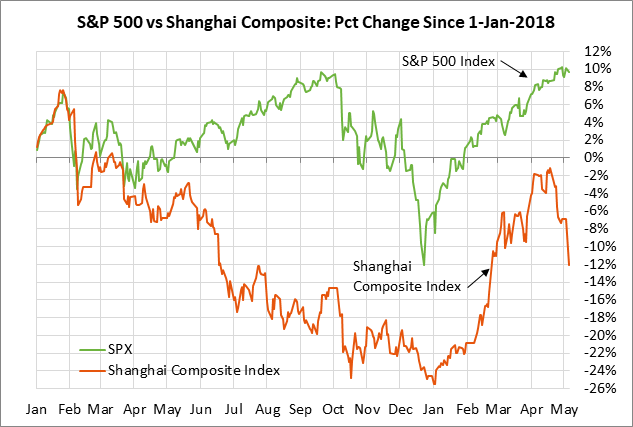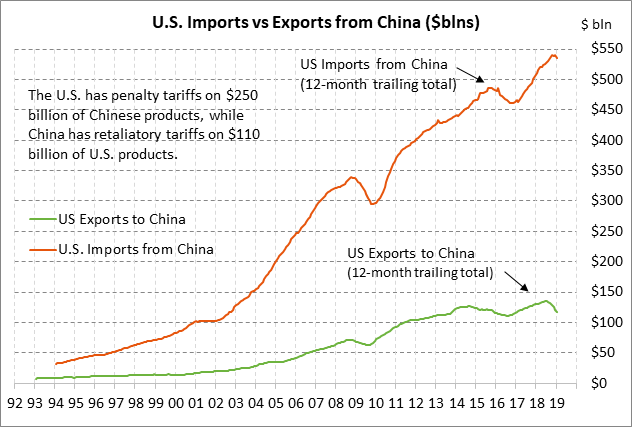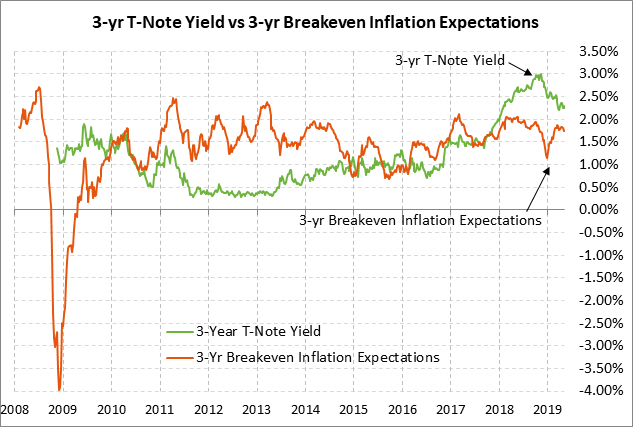- Markets wait to see if US/Chinese trade talks remain on track
- JOLTS job openings expected to partially recover
- 3-year T-note auction to yield near 2.25%
Markets wait to see if US/Chinese trade talks remain on track — The markets are waiting to see if the US/Chinese trade talks remain on track after President Trump on Sunday said he will raise tariffs to 25% from 10% on $200 billion of Chinese goods this Friday if there is no trade agreement this week. USTR Lighthizer late Monday afternoon then confirmed that the higher tariffs will apply starting this Friday at 12:01 am. Mr. Trump also said that he would slap a 25% tariff on the remaining $325 billion of Chinese goods “shortly” if there isn’t a trade agreement.
Bloomberg reported that a dispute began last week when China told USTR Lighthizer that China would not change any laws to implement a trade deal. Mr. Lighthizer took that to mean that China was backtracking on its apparent promise to revise laws to halt the practice of forced technology transfers. The perception that China was backtracking on previously-agreed-upon measures in the trade agreement led to Mr. Trump’s threat of new tariffs. Treasury Secretary Mnuchin said Monday that China over the weekend then sent a revised draft of the agreement that pulled back in a number of areas, leading to President Trump’s tariff threat.
This week’s US/Chinese trade talks are now up in the air. USTR Lighthizer said he still expects China’s trade delegation to show up in Washington for talks on Thursday and Friday. Those talks were previously scheduled to begin on Wednesday. The Chinese Foreign Ministry on Monday said that Chinese officials would still travel to Washington but no departure date was provided. Some Chinese working-level officials that were due to leave on Monday for Washington delayed their departure, according to the WSJ.
Even if China’s working-level trade negotiators show up for this week’s meetings, however, the question is whether Chinese Vice Premier Liu will still travel to Washington to lead the talks. China is reportedly still deciding whether Mr. Liu will travel to Washington this week with some talk that he might delay his arrival or not show up at all. If Mr. Liu does not show up for this week’s meetings, then there would seem to be little chance for a final trade agreement by this Friday.
The markets were initially hopeful that Mr. Trump’s tariff threat on Sunday was simply a last-minute negotiating tactic. However, it now appears that it was not simply a tactic and that the threat was made in response to a fundamental dissatisfaction with the direction of the talks.
If China doesn’t back down quickly and avoid new tariffs on Friday, then the US/Chinese trade war could quickly get much worse. If President Trump goes ahead on Friday with raising tariffs to 25% from 10% on $200 billion of Chinese goods, then China would undoubtedly retaliate in kind. China at that point might also simply decide to walk away from the trade talks for a number of months as they have before. President Trump might then go ahead with his threat to slap a 25% tariff on the remaining $325 billion of Chinese goods. That could be enough to permanently rupture US/Chinese trade relations for the duration of the Trump presidency.
Time is already growing short for a trade deal. If China were to walk away from talks for a number of months, then any new talks would start colliding with next year’s presidential campaign when President Trump will presumably want to be seen as dealing with China in a harsh manner. If time slips past this summer for a US/Chinese trade deal, China might simply decide to wait until next year’s November presidential election to see whether President Trump is reelected. In the meantime, US/Chinese tariffs would likely be at maximum levels and a US/Chinese trade war would be at full blast.
JOLTS job openings expected to partially recover — The market consensus is for today’s March JOLTS job openings report to show an increase of +263,000 to 7.350 million, recovering about half of February’s -538,000 plunge to an 11-month low of 7.087 million. The sharp drop in job openings in February was a potential warning sign of an impending drop in hiring. Indeed, payrolls showed a particularly weak report of only +33,000 in February but then recovered to +196,000 in March and +263,000 in April. The payroll data suggests that business confidence and hiring picked back up in March and April, keeping the U.S. labor market strong. Indeed, the unemployment rate in April fell to a new 49-year low of 3.6%.
3-year T-note auction to yield near 2.25% — The Treasury today will sell $38 billion of 3-year T-notes. The Treasury will then continue this week’s $84 billion refunding operation by selling $27 billion of 10-year T-notes on Wednesday and $19 billion of 30-year bonds on Thursday. The 10-year and 30-year auctions will be new issues as opposed to reopenings of existing issues.
The 3-year T-note yield is currently trading at 2.25%, which is only 15 bp above the late-March 1-1/4 year low of 2.10%. The 3-year T-note yield has dropped sharply by -80 bp from last November’s 11-1/2 year high of 3.05% mainly because of the Fed’s turn in January to a neutral policy from its 4-year rate hike regime. The market is now expecting 37.5 bp of Fed rate cuts through the end of 2020.
The 12-auction averages for the 3-year are as follows: 2.60 bid cover ratio, $88 million in non-competitive bids, 3.1 bp tail to the median yield, 17.9 bp tail to the low yield, and 55% taken at the high yield. The 3-year is the second least popular security among foreign investors and central banks. Indirect bidders, a proxy for foreign buyers, have taken an average of only 46.0% of the last twelve 3-year T-note auctions, which is well below the average of 61.6% for all recent Treasury coupon auctions.



